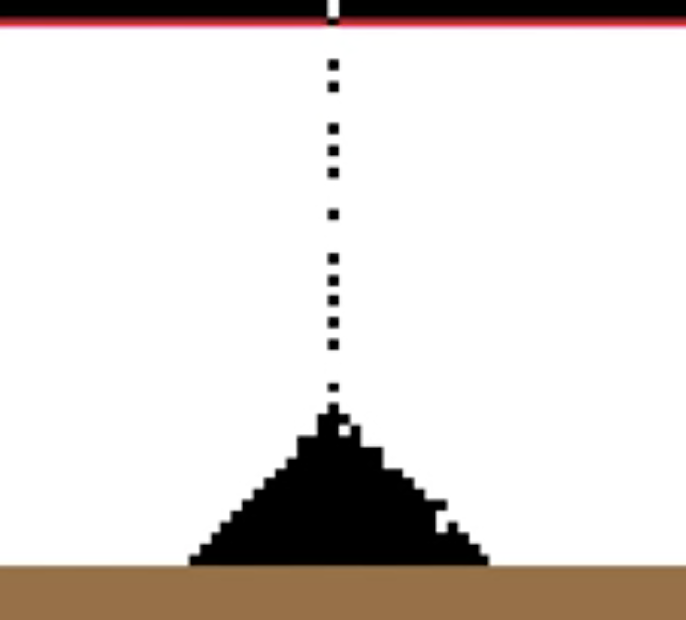cas/definition/feature.php (core concept)

Self-Organized Criticality
CAS tend to organize to a 'critical state' where, regardless of the scale of a given input, the scale of corresponding output observes of a power-law distribution.
Strike a match and drop it in the forest. How big will the resulting fire be? The forest is dry but not overly so... vegetation is relatively thick. Will the fire burn a few trees and then flame out, or will it jump from branch to branch, burning thousands of acres to the ground?
Weirdly uncorrelated cause and effect:
We might think that the scale of an event is relative to the scale of a cause, and in some instances this is indeed the case. But in the context of complex systems, we find an interesting phenomena. These systems appear to 'tune' themselves to a point whereby system inputs of identical intensities (two matches lit on two different days, otherwise same conditions), result in outputs that diverge wildly (a small fire; a massive fire event). The frequency distribution of intense system outputs (relative to equivalent system inputs) follows power-law regularities.
According to Per Bak, a variety of systems naturally 'tune' themselves to operate at a threshold where such dynamics occurs. He defined this 'tuning' as Self-Organized Criticality. A feature of critical states is that, once reached, system components become highly correlated or linked to other system components. That said, the links are exactly balanced: the system elements are linked just tightly enough so that an input at any point can cascade through the entire system, but just loosely enough, so that there are no redundant links needed to make this occur.
Example:
One might think about this like an array of domino-like entities that, instead of being rectangular, are vertical cylinders: able to topple in any direction. The dominos, instead of being arranged in rows, are arranged in a field, with gaps between some cylinders. Accordingly, when a cylinder falls it might strike a gap in the field, with no additional cylinders toppling. Alternately, it might strike an adjacent neighbor, in which case this neighbor will also fall in a particular direction, potentially striking another or potentially dying out. The analogy is made stronger if we imagine that an arrangement whereby, regardless of the direction from which a cylinder is struck, it will wobble and then can fall in any direction. When a system is self-critical, it has reached a state where we can randomly choose any domino to topple and the impact on the overall field will vary according to a power-law distribution. That is to say, that some disturbance will affect only a small number of surrounding dominos, while others will propogate throughout the entire system, causing all cylinders to fall. The occurrence of these large scale versus small-scale cascades follow Power Laws distributions.
Sand Piles and Avalanches
We can imagine that it would be very difficult to, from the top down, create a specific arrangement where such dynamics occur. What is surprising, and what Bak and his colleagues showed, is that natural systems will independently 'tune' themselves to such arrangements. Bak famously provides us with the 'sand pile' model as an example of self-organized criticality:
Imagine that we begin to drop a steady stream of grains of sand onto a surface. The sand begins to pile up, forming a cone shape. As more sand is added, the height of the sand cone grows, and there begins to be a series of competing forces: the force of gravity that tends to drag grains of sand downwards, the friction between grains of sand that tends to hold them in place, and the input of new sand grains that tends to put pressure on both of these forces.
What Bak demonstrates is that, as grains are added sand will dislodge itself from the pile, cascading downwards. What is amazing is that it is impossible to predict whether dropping an individual sand grain will result in a tiny dislodgment of sand cascades, or a massive sand avalanche. That said, it is possible to predict the ratio of cascade events over time - which follows a power-law distribution.
What this suggests is that the sand grains cease to operate independently to forces, and instead their response to forces is highly correlated with that of the other sand grains. We no longer have a collection of grains, acting independently, but a system of grains whereby system-wide behaviors are displayed. Accordingly, an input that affects one element in the system might die out then and there, or, because of the correlation amongst all elements, create a chain reaction.

Information Transfer
It remains unclear exactly how such system-wide correlations emerge, but we do know something about the nature of these correlations - they are tuned to the point where information is able to propagate through the system with maximum efficiency. In other words, a message or input at one node in the system (a grain of sand, burning tree, or toppling cylinder) has the capacity to reach all other nodes, but this with the least redundancy possible. In other words, there are gaps in the system which means that a majority of inputs ultimately die out, but not so many gaps that it is impossible for an input to reach all elements of the system.
Coming back to our original example, when we strike a match in a forest, if the forest has achieved a 'self-critical' state, then we cannot know whether the resulting fire will spread only to a few trees, a large cluster of trees, or cascade through the entire forest. The only thing that we can know is that the largest scale events will happen with diminishing frequency in comparison to the small scale events.
One possible way of understanding why self-organized criticality occurs is to position it as a process that emerges in systems that are affected both by a pressure to have elements couple with one another (sand-grains becoming interlocked by friction or 'sticky') and some mechanism that acts upon the system to loosen such couplings (the force of gravity pulling grains apart). The feedback between these two pressures 'tunes' the system to a critical state.
Complex systems that exhibit power-laws would seem to exhibit such interactions between two competing and unbalanced forces.
Back to Core Concepts
Back to Navigating Complexity
Cite this page:
Wohl, S. (2022, 2 June). Self-Organized Criticality. Retrieved from https://kapalicarsi.wittmeyer.io/definition/self-organized-criticality
Self-Organized Criticality was updated June 2nd, 2022.
Nothing over here yet
This is the feed, a series of related links and resources. Add a link to the feed →
Nothing in the feed...yet.
This is a list of People that Self-Organized Criticality is related to.
Santa Fe Institute; Fitness Landscape
Major complexity theorist associated with the Sante Fe institute, developed idea of a Fitness Landscape
Learn more →Scaling | Criticality | Power Laws
'Fingerprint of complexity' extraction plunger pot, bar single shot froth eu shop latte et, chicory, steamed seasonal grounds dark organic.
Learn more →Self-Organized Criticality
This is a default subtitle for this page. Learn more →This is a list of Terms that Self-Organized Criticality is related to.
Complex systems do not follow linear, predictable chains of cause and effect. Instead, system trajectories can diverge into wildly different regimes. The moment when a complex system move from one trajectory to another is known as a system bifurcation.
This feature of complex systems means that the behavior of a system cannot be known in advance, but instead needs to be enacted in time. Learn more →This is a list of Urban Fields that Self-Organized Criticality is related to.
This is a list of Key Concepts that Self-Organized Criticality is related to.
A tipping point (often referred to as a 'critical point') is a threshold within a system where the system shifts from manifesting one set of qualities to another.
Complex systems do not follow linear, predictable chains of cause and effect. Instead, system trajectories can diverge wildly into entirely different regimes.
Learn more →'Scale-free' networks are ones in which identical system structure is observed for any level of network magnification.
Complex systems tend towards scale-free, nested hierarchies. By 'Scale-free', we mean to say that we can zoom in on the system at any level of magnification, and observe the same kind of structural relations.
Learn more →Complex System behaviors often exhibit power-laws: with a small number of system features wielding a large amount of system impact.
Power laws are particular mathematical distributions that appear in contexts where a very small number of system events or entities exist that, while rare, are highly impactful, alongside of a very large number of system events or entities exist that, while plentiful, have very little impact. Learn more →
Navigating Complexity © 2015-2025 Sharon Wohl, all rights reserved. Developed by Sean Wittmeyer
Sign In (SSO) | Sign In
Related (this page): Nested Orders (23), Tipping Points (218), Power Laws (66),
Section: concepts
Non-Linearity Related (same section): Tipping Points (218, concepts), Path Dependency (93, concepts), Far From Equilibrium (212, concepts), Related (all): Urban Modeling (11, fields), Resilient Urbanism (14, fields), Relational Geography (19, fields), Landscape Urbanism (15, fields), Evolutionary Geography (12, fields), Communicative Planning (18, fields), Assemblage Geography (20, fields),
Nested Orders Related (same section): Self-Organized Criticality (64, concepts), Scale-Free (217, concepts), Power Laws (66, concepts), Related (all): Urban Modeling (11, fields), Urban Informalities (16, fields), Resilient Urbanism (14, fields),
Emergence Related (same section): Self-Organization (214, concepts), Fitness (59, concepts), Attractor States (72, concepts), Related (all): Urban Modeling (11, fields), Urban Informalities (16, fields), Urban Datascapes (28, fields), Incremental Urbanism (13, fields), Evolutionary Geography (12, fields), Communicative Planning (18, fields), Assemblage Geography (20, fields),
Driving Flows Related (same section): Open / Dissipative (84, concepts), Networks (75, concepts), Information (73, concepts), Related (all): Urban Datascapes (28, fields), Tactical Urbanism (17, fields), Relational Geography (19, fields), Parametric Urbanism (10, fields), Landscape Urbanism (15, fields), Evolutionary Geography (12, fields), Communicative Planning (18, fields), Assemblage Geography (20, fields),
Bottom-up Agents Related (same section): Rules (213, concepts), Iterations (56, concepts), Related (all): Urban Modeling (11, fields), Urban Informalities (16, fields), Resilient Urbanism (14, fields), Parametric Urbanism (10, fields), Incremental Urbanism (13, fields), Evolutionary Geography (12, fields), Communicative Planning (18, fields),
Adaptive Capacity Related (same section): Feedback (88, concepts), Degrees of Freedom (78, concepts), Related (all): Urban Modeling (11, fields), Urban Informalities (16, fields), Tactical Urbanism (17, fields), Parametric Urbanism (10, fields), Landscape Urbanism (15, fields), Incremental Urbanism (13, fields), Evolutionary Geography (12, fields),
